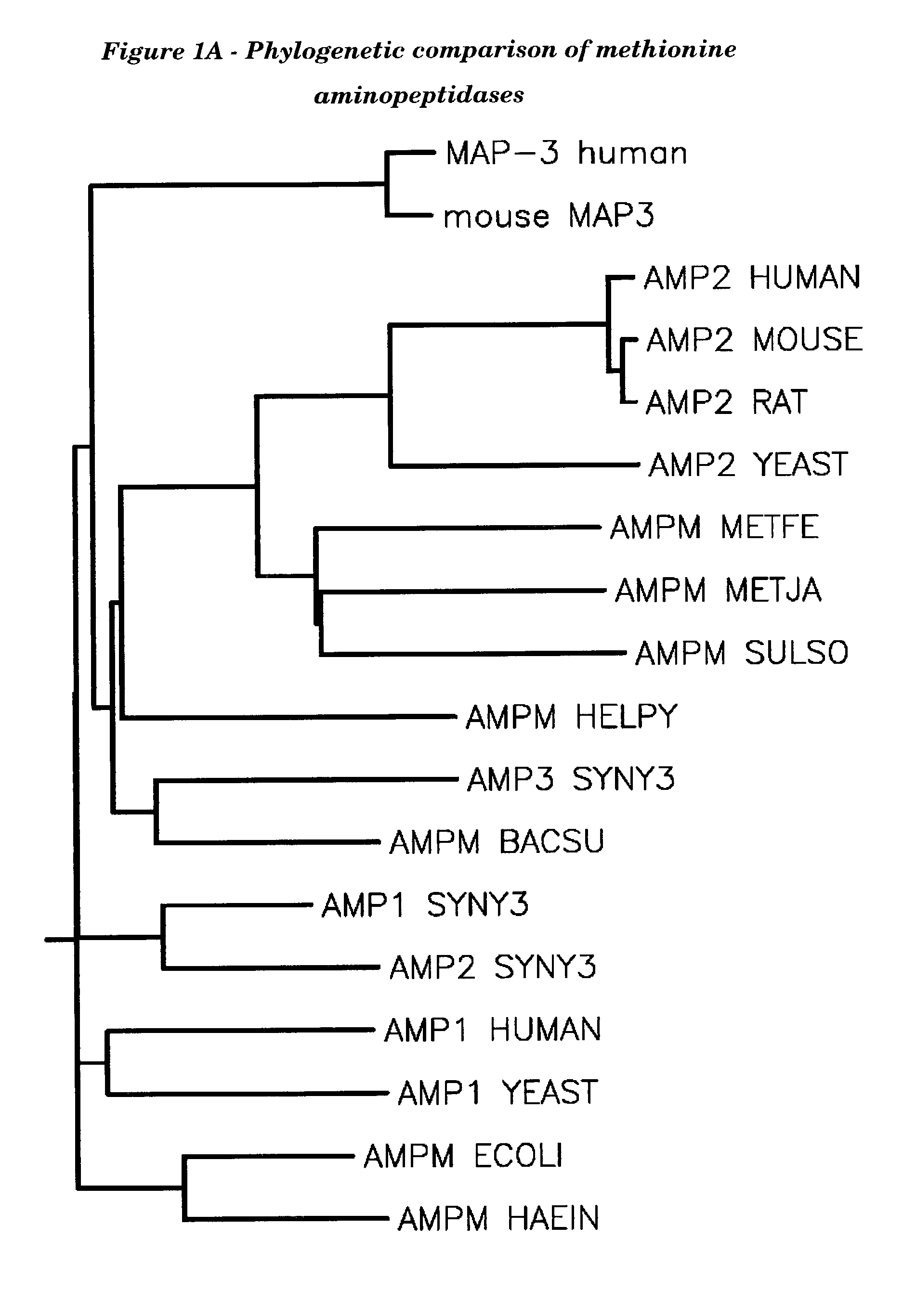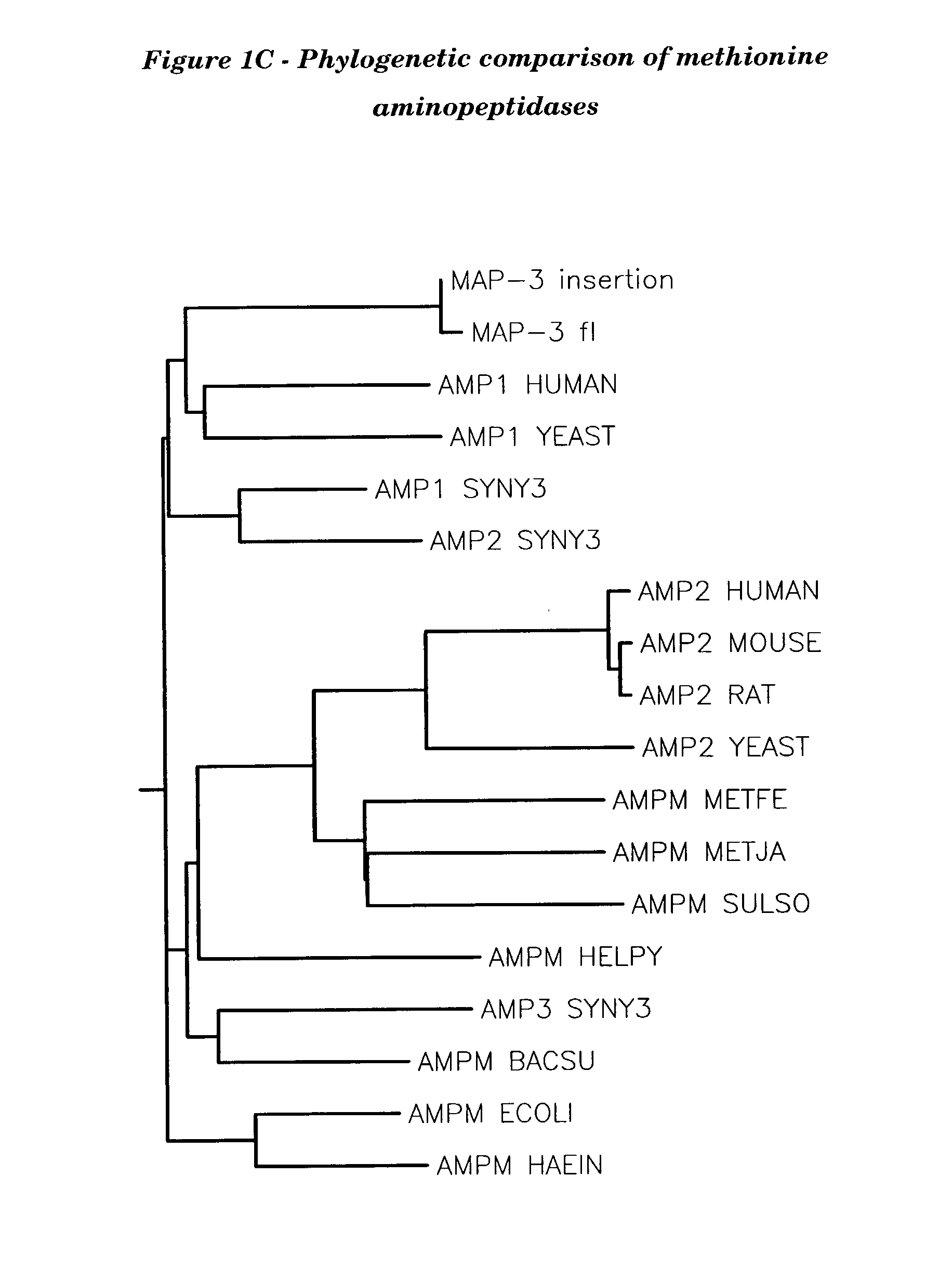Human methionine aminopeptidase type 3
a technology of methionine aminopeptidase and peptidase, which is applied in the field of human methionine aminopeptidase type 3, can solve the problems of compound's limited therapeutic use, insufficient therapeutic window for further clinical advancement, and insufficient signal component specific to endothelial cell cycle regulation
- Summary
- Abstract
- Description
- Claims
- Application Information
AI Technical Summary
Problems solved by technology
Method used
Image
Examples
example 1
[0313] Cloning of a Partial cDNA Encoding MetAP-3
[0314] Cloning of Human MetAP-3
[0315] When the catalytic domains of human MetAP-1 and MetAP-2 were used in search strings in a Blast search (Altschul, S. F., Gish, W., Miller, W., Myers, E. W. and Lipman, D. J. (1990) J. Mol. Biol., 215, 403-410) of an Incyte human cDNA database, a partial clone (with an incomplete open reading frame) was identified (ID 2937276). This sequence was used to design a forward oligonucleotide primer, (MetAP-3 for1) 5'-AGGACGAATGTGGTAAAAAG-3' (SEQ ID NO: 23) that was biotinylated and used as a probe to identify and enrich for the similar cDNAs from human brain, heart, muscle, and transformed baby hamster kidney fibroblast (BHK-HS-5) cDNA libraries using a GeneTrapper protocol (See Example 3, below). The HS-5 cDNA library provided the strongest signals, and an apparent full length clone (with a full length coding region), designated MetAP-3A (MetAP3-GT9D) was isolated. The clone had a .about.3 kb insert whic...
example 2
[0316] Cloning of a Full-Length cDNA Clone Encoding Human MetAP-3
[0317] A second clone, MetAP-3B (MetAP3-HZ2), was obtained from a human brain cDNA library using the GeneTrapper protocol (See Example 3, below) and the same biotinylated forward primer, (MetAP-3 for1) 5'-AGGACGAATGTGGTAAAAAG-3' (SEQ ID NO: 23) The resulting clone, designated MetAP-3B, contained a 1.5 kb insert, which was fully sequenced. It did not contain the 50 bp insert present in the MetAP3A clone, had a truncated 3' untranslated region, and was also missing the entire ATG initiation codon (SEQ ID NO: 7).
[0318] Two oligonucleotides, designated
4 MAP3 FOR + ADAPT + ATG: CTAGAATTCATG GCG GCG CCC AGT GGC GTC (SEQ ID NO: 24) andEcoRI MAP3 REV-NotI: TGCGGCCGCTCA GGCC TCA TGG GGT AG (SEQ ID NO: 25) NotI *** StuI
[0319] were then designed and used to incorporate restriction sites, rebuild the ATG start codon, and amplify just the coding region of this new MetAP-3 gene. The EcoRI site in SEQ ID NO: 24 and the NotI and StuI ...
example 3
[0328] Isolation of MetAP cDNAs Using a GeneTrapper Selection System
[0329] The GeneTrapper cDNA Positive Selection System (Catalog No.10356-046) marketed by Life Technologies, Inc. (Rockville, Md.) was used to identify clones encoding methionine aminopeptidase types 1, 2, and 3 with minor changes in the protocol noted below. The GeneTrapper cDNA Positive Selection System facilitates the rapid (1 to 2 days) isolation of cDNA clones from DNA prepared from a cDNA library (representing 10.sup.12 DNA molecules). In this system, an oligonucleotide, complementary to a segment of the target cDNA, is biotinylated at the 3'-end with biotin-14-dCTP using terminal deoxynucleotidyl transferase (TdT). Simultaneously, a complex population of double-stranded (ds) phagemid DNA containing cDNA inserts (10.sup.6 to 10.sup.7 individual members) is converted to ssDNA using Gene II (phage F1 endonuclease) and E. coli Exonuclease III (Exo III). Hybrids between the biotinylated oligonucleotide and ssDNA ar...
PUM
| Property | Measurement | Unit |
|---|---|---|
| molecular weight | aaaaa | aaaaa |
| molecular weight | aaaaa | aaaaa |
| molecular weight | aaaaa | aaaaa |
Abstract
Description
Claims
Application Information
 Login to View More
Login to View More - R&D
- Intellectual Property
- Life Sciences
- Materials
- Tech Scout
- Unparalleled Data Quality
- Higher Quality Content
- 60% Fewer Hallucinations
Browse by: Latest US Patents, China's latest patents, Technical Efficacy Thesaurus, Application Domain, Technology Topic, Popular Technical Reports.
© 2025 PatSnap. All rights reserved.Legal|Privacy policy|Modern Slavery Act Transparency Statement|Sitemap|About US| Contact US: help@patsnap.com



